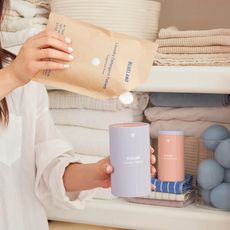Our Favorite Plastic-Free Swaps

Written by: Lydia Mendel social @Blueland
September 8, 2020
This July, Blueland is committing to showing you all the different ways you can cut plastic out of your life. And in honor of Plastic-Free July, we’ve decided to round up some of our favorite sustainable alternatives to single-use, disposable plastic products. These swaps are easy, hip, and better for both you and our environment! So ditch the one-and-done plastics, and check out all the new ways you could live a little more green.
1. Metal Straws
The dangers of plastic straws have been very well documented, but in case you’d like a reminder: Straws make up about 4 percent of all the plastic trash that hits our waters every year. On top of breaking down and leaving microplastics into the waters, they also can directly kill dolphins, whales, fish, aquatic birds, and sea turtles who are attracted to their colors and try to eat them. But there’s an incredibly easy fix: reusable metal, glass and silicone straws! And if you get a set from EcoTribe, you can take your straws everywhere you go with an easy to use travel bag!
2. Cloth Tote Bags
Plastic bags are another well-known pollutant. They start out as fossil fuels and end up as deadly waste in landfills and the ocean. Birds often mistake shredded plastic bags for food and eat toxic debris, while fish eat thousands of tons of plastic a year and transfer it up the food chain to bigger marine mammals. Thankfully, the alternative to plastic bags is also well known: cloth tote bags! Made from eco-friendly linen or cotton, cloth tote bags are plastic-free, reusable, and can be quite stylish. And since most clothing stores, grocery stores, and even furniture stores have them, they won’t be hard to find! Learn more about plastic straws, plastic bags, and the rest of the Big Four, for four easy ways to cut down on single-use plastic!
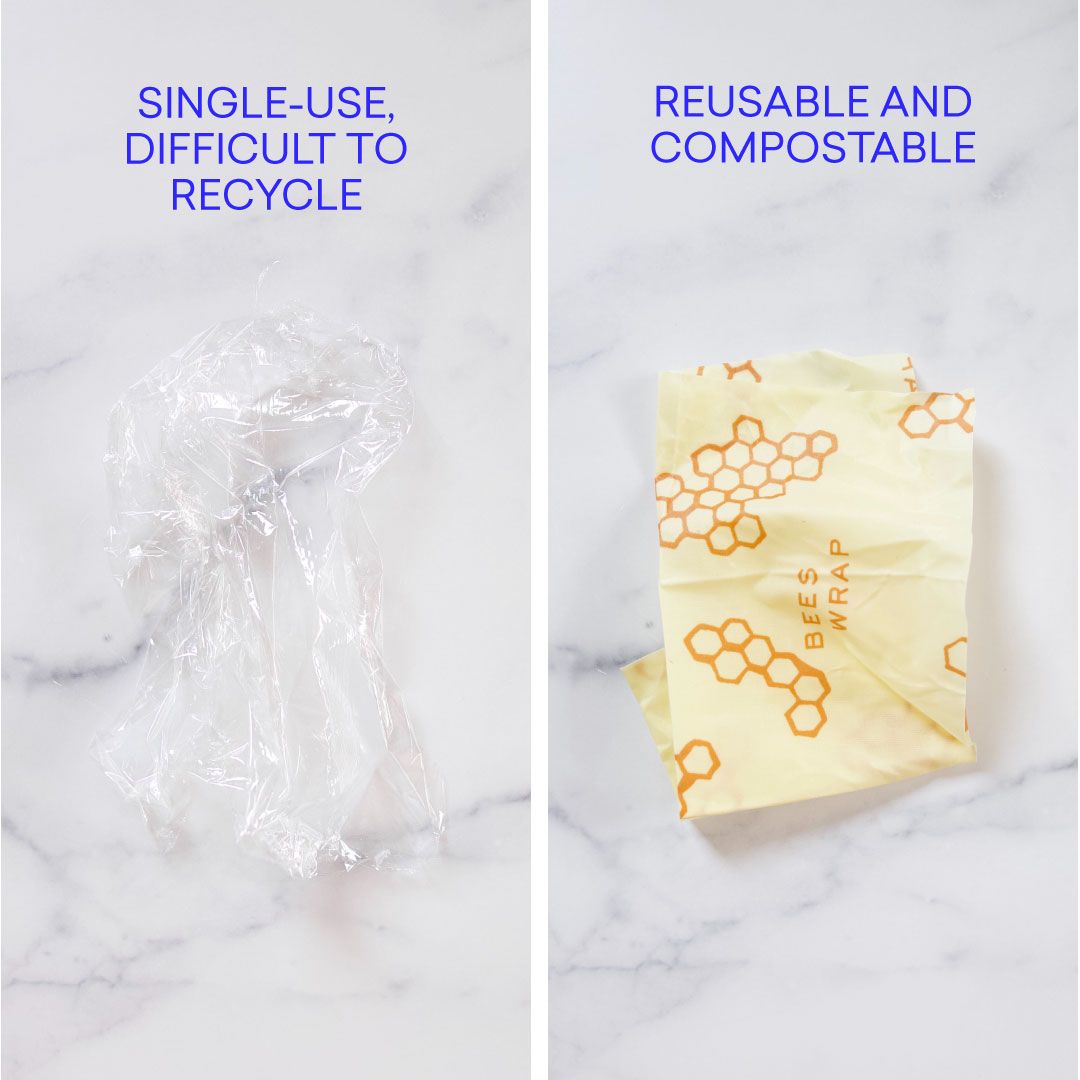
3. Beeswax Wraps
Plastic wrap not only contributes to the 150 million metric tons of plastic currently in our oceans, but it also leaves microplastics on everything it touches. This includes your food, drinking water, and the oceans as well. That’s why you’ll be glad to ditch the plastic wrap and swap it out for organic beeswax wrap like the stuff from Nature Bee and Abeego! Made from 100% cotton, beeswax, pine tree resin, and jojoba oil, each wrap is handcrafted to look great and keep microplastics out of your kitchen!

4. Unpaper Towels
The US alone uses 6,500,000 tons of paper towels every year. Making 1 ton of paper towels uses 17 trees and 20,00 gallons of water, and when these towels end up decomposing in landfills they release methane into the air. Enter Marley’s Monsters Unpaper Towels! Made from 100 percent cotton flannel, these cloth towels are colorful, washable, and absorbent alternatives that even cling together if rolled up on a paper towel roll! You can also make your own unpaper towels out of old fabric you have lying around.
5. Reusable Silverware
Plastic cutlery is one of those items that won’t get recycled, even when you put it in the recycling. It’s too contaminated, small, and lightweight. So those 40 billion plastic utensils made per year are all going into landfills. That’s why you should take a look at some reusable wood silverware like the ones at EarthHero and reusable to-go silverware sets. Sleek, green, and easy to take on the go, reusable utensils will help cut down on your plastic waste while cutting into your lunch!
6. E-readers
It takes roughly 10 liters of water to make a single sheet of standard 8×10 letter paper, and it takes about 1,320 gallons of water to make a single book. Not to mention producing paper books also leads to trees being chopped down all over the world. So if you’re an avid reader, it’s worth switching over to an e-reader! Studies show the CO2 emissions created by a single e-reader equate to roughly 100 books, and that if allowed to reach their full life-cycle and capacity, e-readers could reduce emissions of up to 4 trillion pounds of CO2! And yes, E-readers can even newspapers and magazines too.
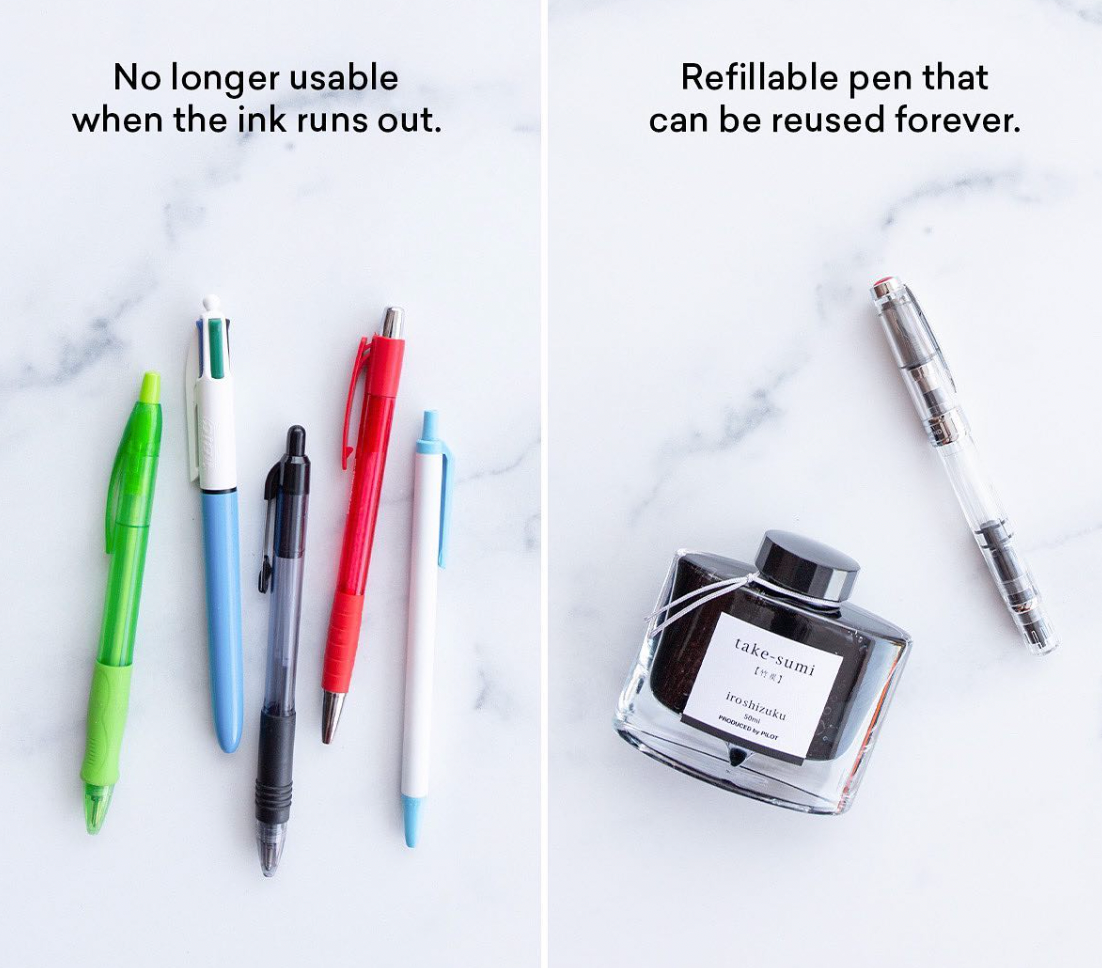
7. Refillable Pens
According to the EPA, 1.6 billion disposable pens end up in landfills every year. Very few places recycle pens, as they are hard to separate into different components, and they all come packaged in plastic. So that’s a lot of metal and plastic that’s not decomposing in a landfill! So, instead of buying a new set of plastic pens every few months, try a refillable fountain pen! They are easy to use, and you can refill them over and over again with ink that comes in a glass bottle! Some of our favorite refillable pens come from Muji and Goulet.
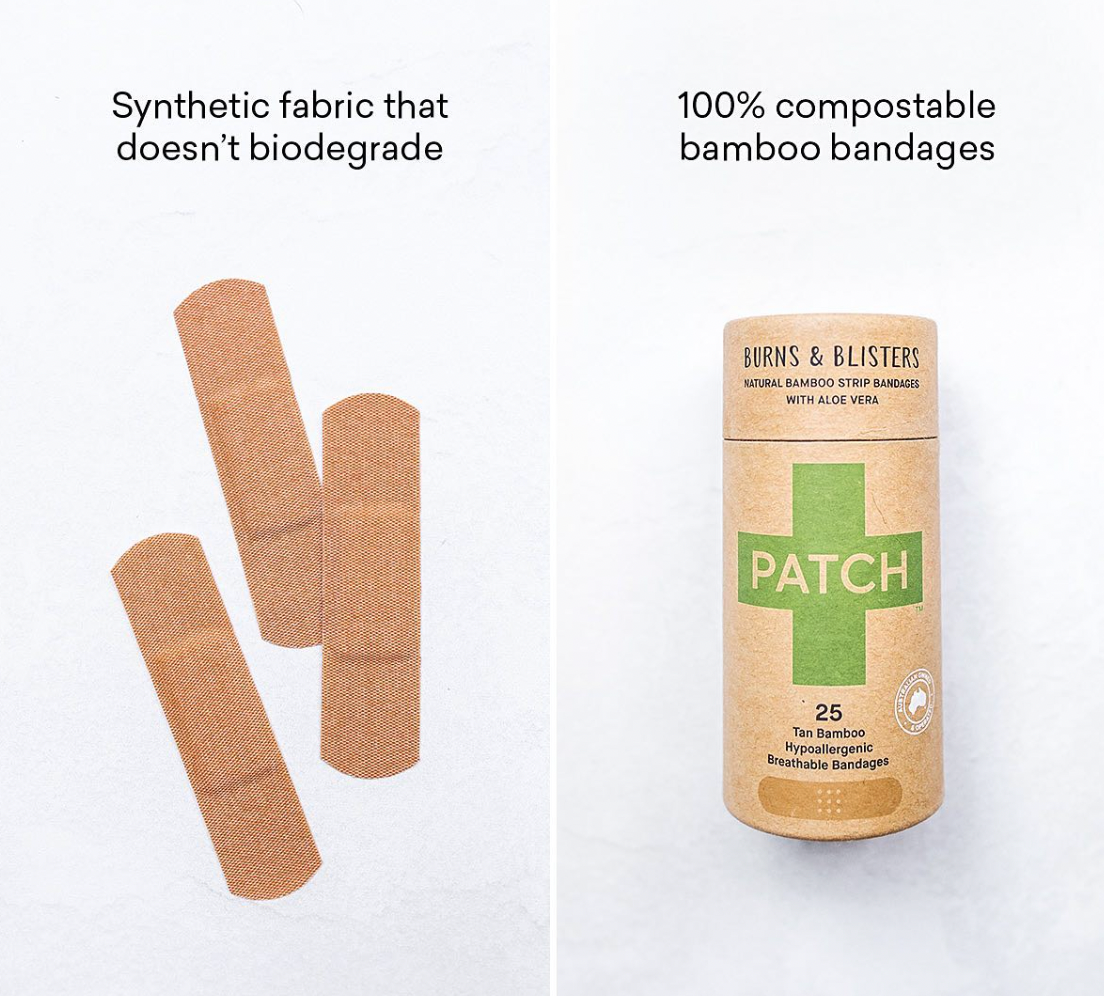
8. Bamboo Bandages
Did you know most single-use bandages are made from plastic? The adhesive sheet of a is usually made from plastics like PVC, polyethylene, or polyurethane. These plastics don’t break down, are single-use, and have to be incinerated to be disposed of! That’s why it may be time to look for an alternative way to cover that cut. Thankfully, bandages from Patch are crafted with 100% organic bamboo fiber, activated charcoal, aloe vera and coconut oil. These natural bandages are in fact so green, there’s no reason not to put bamboo on those boo-boos!
9. Face Masks
Most disposable beauty masks are made of nylon, plastic microfibers, and polyester. They contribute to the 2 million metric tons of plastic waste the beauty industry puts into our oceans every year. Thankfully, brands like Follain and Loli make non-toxic, plastic-free face mask creams to exfoliate your face and our oceans!
10. Plastic-Free Tape
Manufacturing the synthetic resins, plastic films, and pulp products used in adhesive tapes consumes significant amounts of electricity and energy, leading to greenhouse gas emissions. Sticky residues and tape left behind by adhesives hinder recycling, the burning of tapes releases harmful air pollutants, and the plastic tape itself is almost never recycled. That’s why EcoEnclose makes plant-derived, renewable, and naturally biodegradable tape. It’s water-resistant, dependable, and will help you seal up your boxes guilt-free!
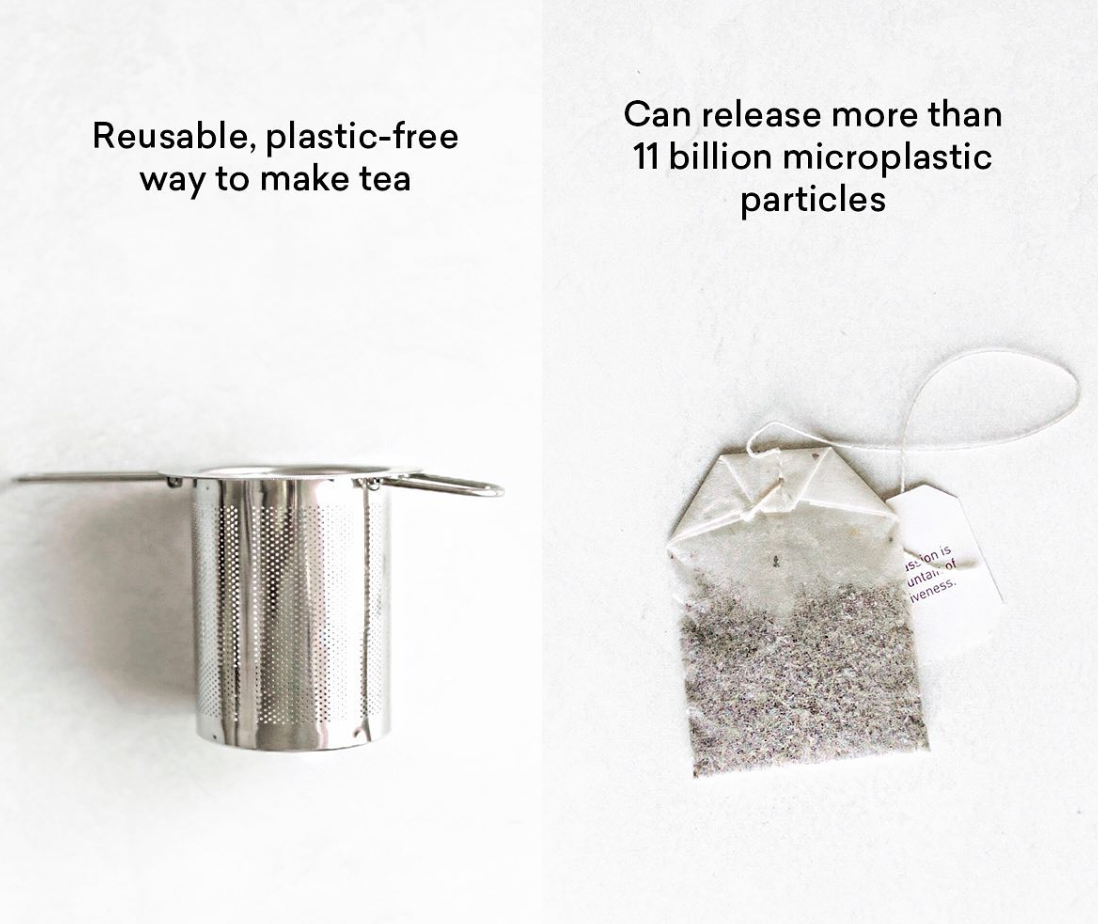
11. Tea Strainers
Canadian researchers published a study that found that steeping a single plastic tea bag releases about 11.6 billion microplastics and 3.1 billion nanoplastics into each cup. This is because a plastic polymer called polypropylene helps tea bags keep their shape. Not all tea bags are made from plastic, but many have glue or other components that make it hard for tea bags to completely decompose. But if you switch to buying large bags of tea and reusable metal or silicone steepers like the ones at TopicTea, you can brew tea even greener than before!
12. Reusable Snack Bags
The average American family uses 500 plastic snack bags a year! This is not great since these bags are mostly made from polyethylene, do not decompose in landfills, and can contaminate your food with BPA. You can easily zip away plastic snack bags, though, if you switch over to Stasher Bags or ZipTops!These silicone bags are endlessly reusable, keep plastics out of our foods and oceans.
13. Cloth Diapers
An estimated 20 billion disposable diapers are added to landfills each year, creating about 3.5 million tons of waste. And according to the EPA, disposable diapers might even introduce pathogens into the environment =. But you can wipe away this mess by switching to cloth diapers like the ones at GroVia! Cloth diapers are cheaper in the long-term, minimize exposure to unknown ingredients, and keep disposables from filling up our landfills!
14. Loofahs
A lot of people confuse the loofah and the pouf, but they are actually very different. The pouf is made of colorful synthetic materials that are gathered into a fluffy ball, and are meant to be thrown away. This means they will ultimately sit for hundreds or even thousands of years in a landfill or a waterway like the ocean. And like many other plastics on this list, they also cause microfibers to get washed down the drain and into the local water source. Loofahs, on the other hand, are made from the luffa plant. These plants can be re-grown, making them especially sustainable, and can be composted when you are done using them. So make the switch with natural loofahs like the ones at Nature’s Garden!
15. Bamboo Toothbrush
1 billion plastic toothbrushes are thrown away every year, 50 million of which end up in landfills. The production of the fossil fuel-derived materials used to make toothbrushes creates very potent greenhouse gases and kills marine and avian life (such as albatrosses) that try to eat them. So why not opt for a bamboo toothbrush? Made out of bamboo and castor bean nylon, these brushes keep plastics out your oceans, out of your mouth, and just so happen to look very chic as well.
16. Reusable Razors
Razors help us look fresh and clean. Too bad they don’t also do that for the environment. In fact, the Environmental Protection Agency estimates 2 billion razors go to waste every year. This is unsurprising given the fact that 163 million consumers use disposable razors only, and are going through roughly 60 razors a year. These numbers sound even worse after considering that disposable razors require fossil fuels to be made, they are not easily recyclable, and the end up as non-biodegradable plastics in landfills. Luckily, there are people out there making sustainable razors that you can use again and again. So why not switch over to shaving with razors from Oui the people of Leaf. Their steel razors are reusable and can help cut down on plastic waste!


